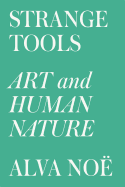
A love letter to art, Alva Noë's Strange Tools: Art and Human Nature ironically lays out the claim that art is physically useless. Think of a doorknob, he says. "When you walk up to a door, you don't stop to inspect the doorknob; you just turn it and go right through." Doorknobs, Noë explains, are a common part of modern life; they exist because people need doors and doors need knobs. They are perfectly designed tools specifically because they are unnoticed. If doorknobs puzzled people, if people had to stop and think about how to use them, they'd be poorly designed.
"This brings us to art," Noë writes. "Design stops and art begins when we lose the possibility of taking the background of our familiar technologies for granted." Art is a strange tool because there is no discernible use for it, but that is exactly why art is so necessary.
Noë argues that art reaches a place in the human mind that is unexplainable by neuroscience. Choreographers, he says, don't dance--they show dancing. Painters don't make pictures, they call attention to painting. And the mind's capacity to discern this is proof that art is a part of humanity's identity.
Noë teaches philosophy at the University of California, focusing on cognition and the philosophy of neuroscience. If an entire book about the importance of art seems like a departure, he argues that it isn't. Strange Tools is a conversation between Noë and his readers about how art manifests itself in the brain, and how the brain works to make use of this strangest of tools. --Josh Potter

